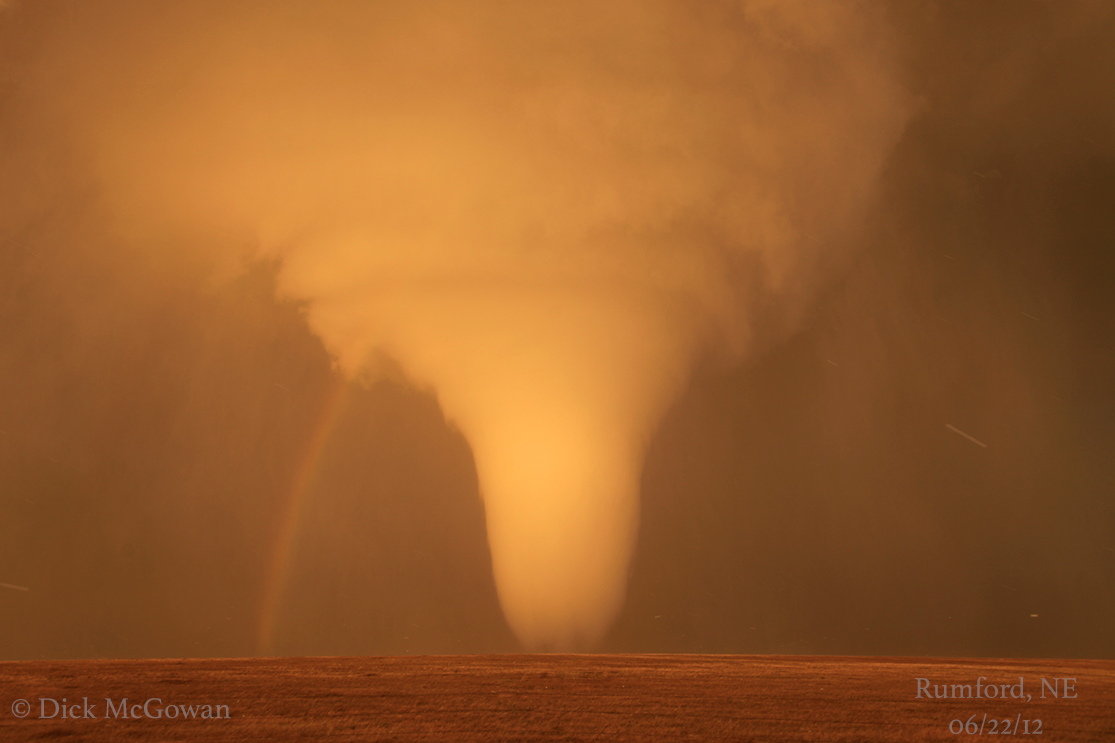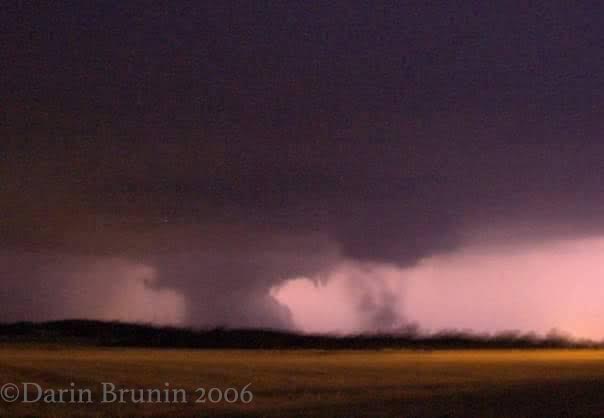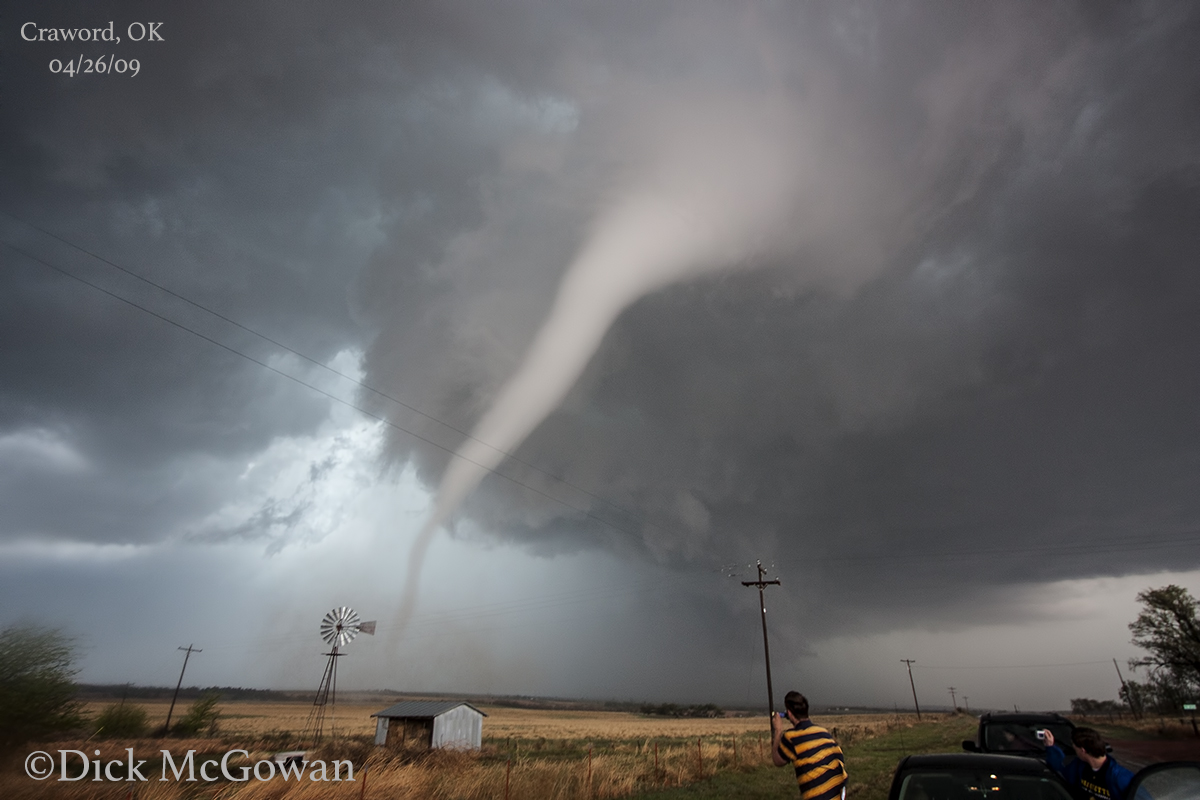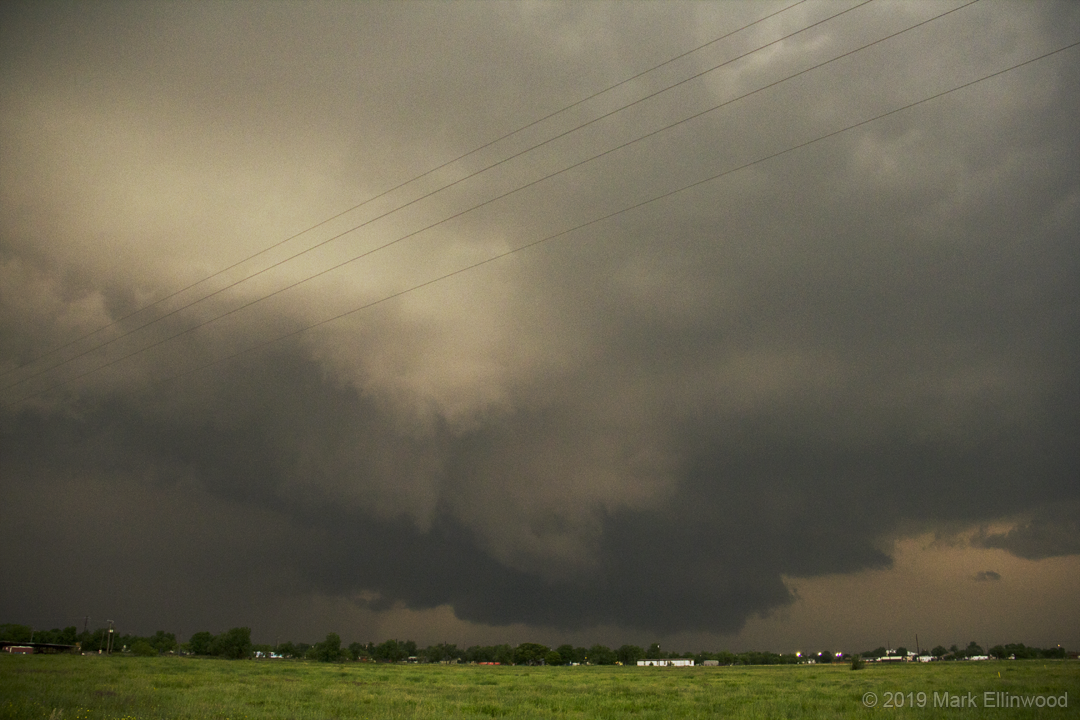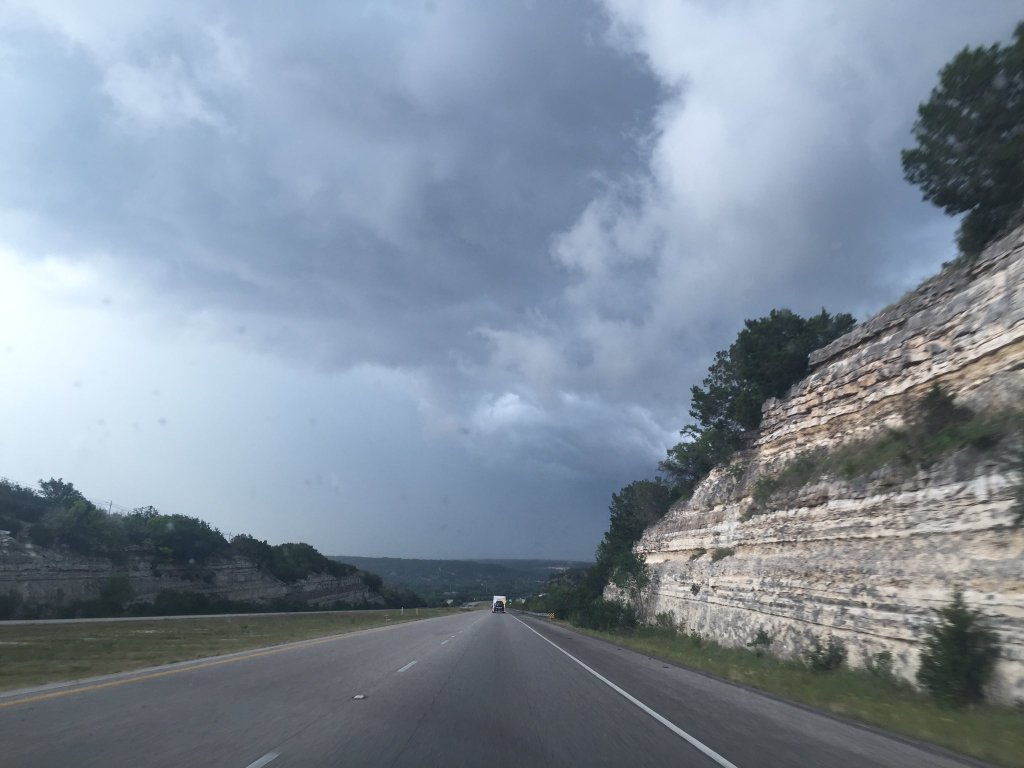There are a handful of names across the storm chaser community that get a response from most folks. Dick McGowan is one of those names.
In his chasing career, which has included driving the first “tornado tanks” in existence, he’s seen more tornadoes at close range than just about anyone.
And while some may think that’s reckless, anyone who knows Dick knows he is a master at the craft. He doesn’t take on more risk than he can handle. It’s one reason why, year-to-year, he delivers some of the finest imagery of tornadoes doing their thing.
I was fortunate enough to grab a few moments of Dick’s time. I’ve had a number of questions I’ve been eager to ask for years, and he agreed to share them with the world.
Q: Thanks again, Dick. It’s almost May! The first question I ask everyone in a Q&A: When did the bug hit? It seems most fall in love with weather at a young age. Was that the case for you? Was there a specific event that did it?
Dick McGowan (DM): Hey Ian, thanks for having me, I really appreciate you reaching out to me!
The weather bug definitely hit me at a young age. I had moved from South Padre Island, TX area to Garden City, KS—which is located in Western Kansas, right in tornado alley. When I was 1 month old, Hurricane Allen, somewhat destroyed our tiny home in Brownsville, TX. When I was 8, I remember preparing our house for Hurricane Gilbert, which was thought to take a direct, hit on our home—instead, made landfall in Mexico. But, I remember driving around Harlingen, TX, and seeing all of the houses boarded up with sayings like, “Gilbert, you scumbag, go away!” And thankfully, it made landfall in Mexico, but I remember all of the tornado warnings we went through, spawned by Gilbert’s outer bands.
Fast-forward to 1990, in Garden City, KS: I was with my parents and we were picking up my sister from dance class on Main Street. As a curious child, I notice the clouds to our west had this “swirl” to them, and asked my mother, “Is that a tornado?” She assured me it was not. Not 5 seconds later, the tornado sirens blew and what was a swirling cloud mass, was now stretching into a full-fledged tornado! I remember my dad, hurried all of us into our van, and squealed the tires—fleeing the scene from a tornado coming at us! He was doing speeds of what seemed like 60 mph in residential areas, until we made it to my uncle’s house, where we took cover. The excitement, from that, and witnessing a beautiful tornado develop at such a young age, eventually guided my path towards storm chasing.
My mother, who survived the Topeka, KS F5 tornado of 1966 (which also completely leveled my grandfather’s pharmacy), developed a phobia of tornadoes. Any thunderstorm that would develop, she made sure my sister and I were underground. One day — nearly paralyzing my mother in fear — I wanted to go upstairs and see what I was missing during a “tornado warning.” I witnessed baseball-sized hail hitting our roof and smashing our neighbor’s windshields. It amazed me.
When I was very little, I was terrified of thunderstorms, more from the lightning and thunder, and would cry. So, I kind of had this fear and interest in weather. In 1995, at only 15 years old, I had some of my first run ins with storm chasing. Maybe the most important was when my mother, unaware of any watches or warnings, told me to pick up my sister at “the mall.” The mall, wasn’t really a mall, it was a strip mall, that us, small-town, beef-packing plant dominated people would call a mall. After I picked her up, the radio I was listening to, broke through with a tornado warning, and the tornado was reported north of town on 6-mile road and Jenny Barker Rd. just 6 miles from me! But, without going up the “hill” of Jenny Barker road, one could not view a storm due to the terrain, so I floored it up Jenny Barker Road, and witnessed my first successful storm chase (as some would call it), where a rope tornado “skipped” up and down as it moved southeast and away from Garden City, thankfully. My sister still talks about this day, because she kept telling me to turn around and eventually started to cry, so I did, after we both had a little fear as to what the storm was going to do.
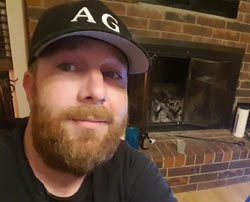
Dick McGowan is a storm chaser of 14 years and resides in Norman, Oklahoma. His videos and pictures have been featured on all major networks worldwide, and his photos have been published in magazines such as Maxim, Outside Magazine, and Men’s Health. Photos have also appeared in Times Square. He was a production assistant, photographer and driver for Storm Chasers on the Discovery Channel, and co-starred on the docudrama, web series, Tornado Chasers. His passion doesn’t stop with storms, he’s also huge animal lover and donates his time and money to helping cat colonies.
Q: As most ustornadoes.com readers probably know, you’ve been storm chasing since 2003 and were part of the Discovery Channel hit Storm Chasers. How have things changed in the years you’ve been at it? Have you noticed a significant difference in the number of people roaming the Plains?
DM: You know, there has always been traffic since I’ve been chasing, especially on the big days that the public is well aware of and is near a good-sized city. The well-known Mulvane, KS tornado event in June of 2004 was a madhouse, even Memorial Day weekend in 2004, there were a LOT of chasers back then. But, it does seem, today, that there are a lot more chasers out, especially after the airing of Storm Chasers and other shows, depicting chasers “in real life.”
I know a lot of veterans, who chased pre-Twister, also noticed the massive influx of storm chasers in the field, past 1996. Honestly, I have seen the movie twice in my life, and it was never something I thought I’d be doing, today. In 7th and 8th grade, my friend Seth and I always dreamt of one day buying our own video camera and working for The Weather Channel, as we always had it on, waiting for something to happen and listening to the joyous music they used to play.
But, back on the subject. With the technology that’s advanced today, it is much easier for one to see a tornado today than it was back then. So, I think the newer generation of chasers, depend a lot on technology, and the knowledge of seasoned chasers, to get them to the tornadoes…which I, myself, can be guilty of every once in a while (technology-wise). As for the crowds, my friend, and chasing partner Joel Taylor has always said, “The crowds thin out once you’re within a mile or less of a tornado.”
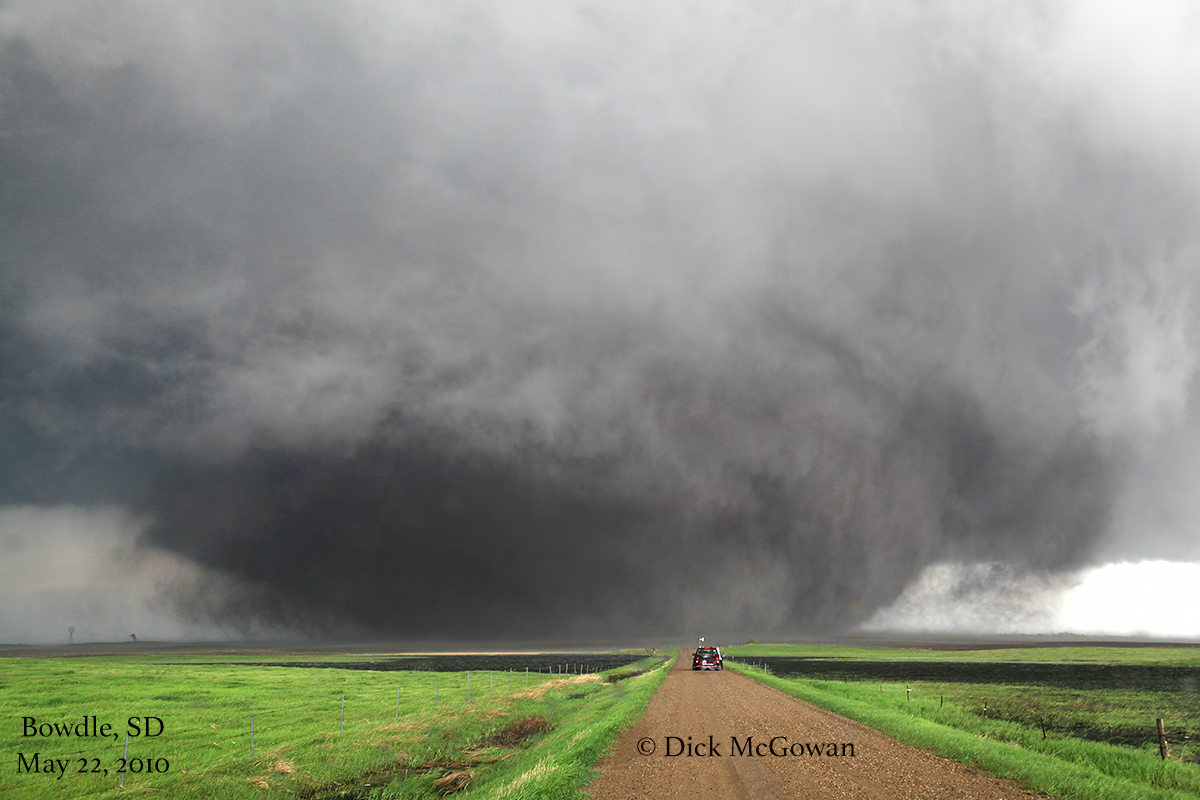 Q: It’s no secret that you like to get close. “How close is too close?” is a debate that rages both inside and outside the storm chaser community. As you may know, I’ve voiced my thoughts with others that being farther back offers more of the full-storm experience, but I admit I still dream of being close enough to really feel it.
Q: It’s no secret that you like to get close. “How close is too close?” is a debate that rages both inside and outside the storm chaser community. As you may know, I’ve voiced my thoughts with others that being farther back offers more of the full-storm experience, but I admit I still dream of being close enough to really feel it.
DM: How close is to close? That is, undeniably, debatable. For myself, it’s as close to the tornado as I can possibly get, without injuring myself, or anyone else in my vehicle or anyone else in my caravan. There are some tornadoes that one can get within 100 yards or so, and others I wouldn’t be within a mile of. Take for instance, the El Reno tornado.
Q: Are there visual clues you use to “safely” (don’t try this at home) get close?
DM: While chasing with Reed Timmer, his/our usual plan of attack is to attack early on. With El Reno, we did as the merry-go-round wall cloud was violently rotating. As it spun up its first vortex, I felt like I could get extremely close to it, so I did. But make no mistake about it, even though I’m driving, and sometimes filming, I’m playing very close attention to the tornado’s “occlusion” AKA, the clear slot.
The occlusion can expand, shrink, go north, south, east, or west, depending on the environment it is in. In El Reno’s case, I got within 50 yards or so, as it was developing, but noticed an extremely rapid expansion, which was expanding northward and putting us in a very dangerous position. So, I backed up to a mile or so back, while we watched the tornado spin several more vortices, before planting into an HP wedge, from the north/northwest. While watching it, from inside the vault region, we started to experience softball sized hail, and one of our friends measured a 6 inch stone in the same general area, so, my crew, not being in an armored vehicle, flew south to avoid softballs, some of which, were now coming sideways.
Something told me to go south one more road, so I did. Unfortunately, the rear inflow jet of this storm was now swaying powerlines, a good mile or two southwest of the tornado, so I was forced to turn back around and go another mile south. This, ultimately, saved us, from what could have been the same, unfortunate result, as the TWISTEX crew. I usually won’t get too close to “wedges,” they aren’t my favorite type of tornado. They’re, for the most part, the most destructive, deadliest and “ugliest” tornado, IMO.
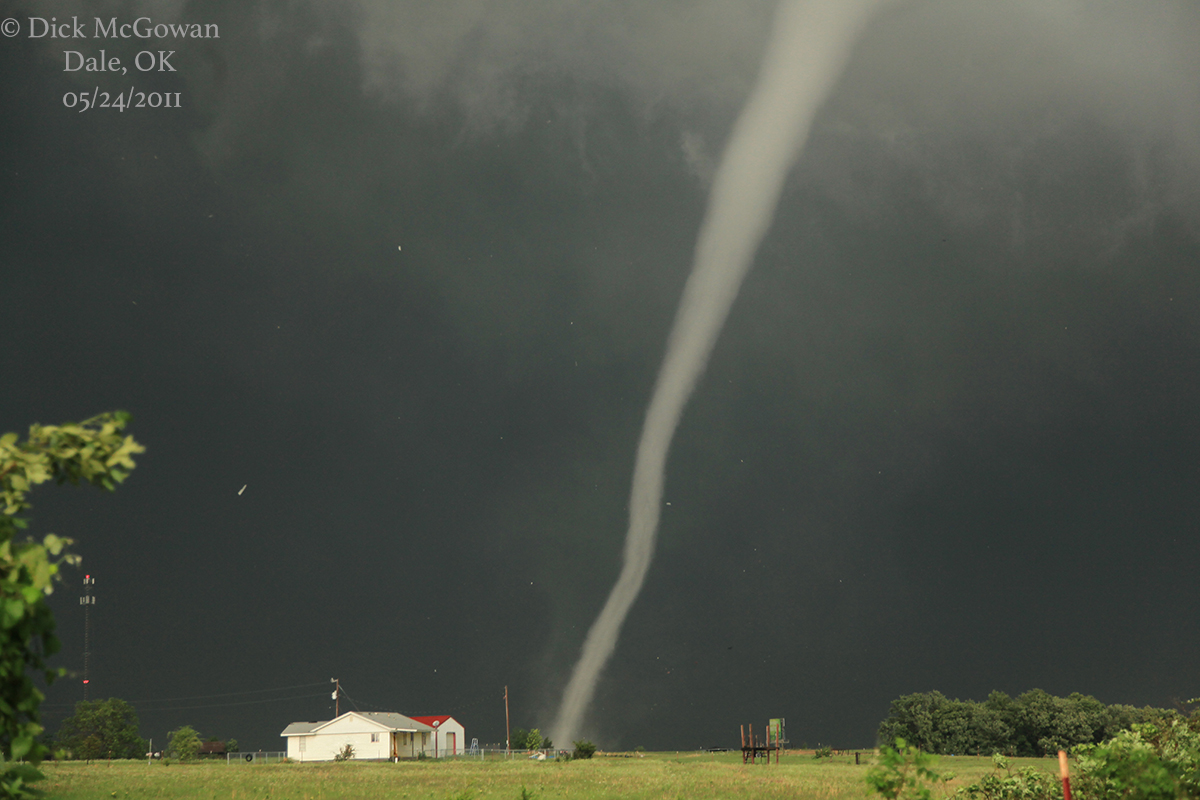 Q: What made you yearn to be right up in the tornado action?
Q: What made you yearn to be right up in the tornado action?
DM: Well, the detail of the tornado, is, how do I even put this into words, seems so fake. When I chase, I want to “feel” the tornado, and see it from the front row, as safely as possible.
There’s just something about being 100 yards away form a tornado, and looking all the way up at the funnel that I yearn for every year. I know, it’s looked down upon to some, but I’m not out there to chase for “their ways,” I’m out there to document tornadoes for myself, and my friends who have passed away, way before their time. Whenever I’m out there, and the forecast is a tough one, I seek guidance from my late, chaser friends, and my best friend who passed, Andy Gabrielson. As silly as this may sound, he and others have guided me to the perfect roads, sometimes, where I’m able to get close and see Mother Nature’s most violent tempers, from close-range.
Chaser Q&As: Veteran Storm Chaser Amos Magliocco | Long-time Chasecationer Chris Kridler
Q: Is getting close to the tornado always your goal?
DM: Yes.
It’s true, there is a “danger zone” that only a few risk, or know how to do it safely, consistently…and it takes years of chasing, hundreds, perhaps even a thousand supercells, to identify the mechanics of a supercell, and feel comfortable enough around them (ha, I say this in the comfort of my own home, after the fact). As crazy as that may sound to some, but my #1 goal is to get as close as possible, to see tornadoes from so close, so I can view/document the fine-scale details that go on from close-range.
While I have chased the “Reed Timmer” way, making a home for ourselves in the proclaimed “bear’s cage” for the last 5-6 years, this year, alongside my old chasing partner, Darin Brunin (Worked for Sean Casey and his I-Max films, among other projects), we will be reviving our original style of storm chasing: Watch from afar (for structure and other notable features), then attack when we believe the supercell will produce a tornado. As much as I have enjoyed my time, living in the constant, white-knuckle bear’s cage; I’m getting too old to push it to the absolute extreme, and will only enter the bear’s cage when absolutely necessary.
Q: Let’s stay with tornado close-ups for a moment more. Have you ever been too close for comfort? Are there situations where you have felt scared for your safety?
DM: Yes, many times I have been too close for comfort. I’m actually pretty shocked I’m able to sit here and write answers to your questions, given the circumstances I’ve encountered over the last 13 seasons.
Q: Please detail your most intense!
DM: March 12, 2006 – This was a high risk day, with a very dynamic system, an open gulf, and plenty of moisture/sunshine/instability, with multiple rounds. After starting the day at 11:30 a.m., Mike Deason, Darin Brunin and I had already core-punched a storm east of Lawrence, KS—leaving us with baseball-sized hail cracks on our vehicle’s windshield and losing that storm as it rocketed northeast at 65 mph.
We then, made it to the “Sedalia, MO” tornado, during the day, only to not be able to see it, with debris falling on top of us. Having no internet/GPS back then, we thought the day was over and were filming lightning on new storms that had fired on the dry line, around dusk. I’ll never forget how quickly things went from zero to 100 in about 3 seconds. Over the vehicle’s radio, we heard the weather radio go off and say that this storm to our W/SW was tornado warned with, I believe, a large and extremely dangerous tornado reported. What was light northerly winds, while filming lightning, quickly turned into screaming 65 mph inflow (the most intense inflow, to date, I’ve felt) and a “wedge” tornado appearing, clear as day, out of the rain.
The tornado was headed, from what we believed, for Marshall, MO. I called 911 and reported my location and a half-mile wide tornado headed for Marshall, MO. As the inflow picked up, Darin left his door open on Mike’s Jeep, and boom, the hinge breaks. The inflow seems to increasingly pick up even more and we notice a brand new tornado, developing just a mile to our north! Wow, we have twin tornadoes, after a frustrating day, and it may be heading for Marshall, MO (Officially, it turned right, missing Marshall by only a few miles). We couldn’t keep up with this storm either, as it was moving northeast at 65 mph.
Connect with Dick: Twitter | Flickr
We could see a new storm to our SW and by listening to the location of this new tornadic storm, used a paper map and mapped out our intercept point—which just happened to be north of Sedalia (round 2 for them!). We punch it, zig-zagging county roads with names such as JJ or KL, until we finally hit the 4 lane highway that runs N/S through Sedalia, MO. We see power flashes off to our immediate SW as forward flank winds, now turn into extremely strong inflow winds. This was an “uh-oh” intense moment. Mike is driving, Darin is in the passenger seat, and I’m in the back. All of a sudden, power flashes illuminate a not-fully condensated tornado, and it is coming directly at us. We have exactly 2 choices and only a half-second glimpse of where it was (approx. ¼ mile away, moving NE at 65), I yell “Stop, stop.” Darin yells, “Go, go, go!” And Mike, floored it…it felt as if the gas he hit was having zero effect on our escape, it was too late. My idea of stopping, would’ve put us in a direct hit, but Mike’s great judgment of flooring it, only put us in the outer circulation as debris of all sorts hits the vehicle, and power flashes on the highway, illuminate a much bigger tornado, than previously seen, where we would stop, eventually and watch it grow into another wedge tornado.
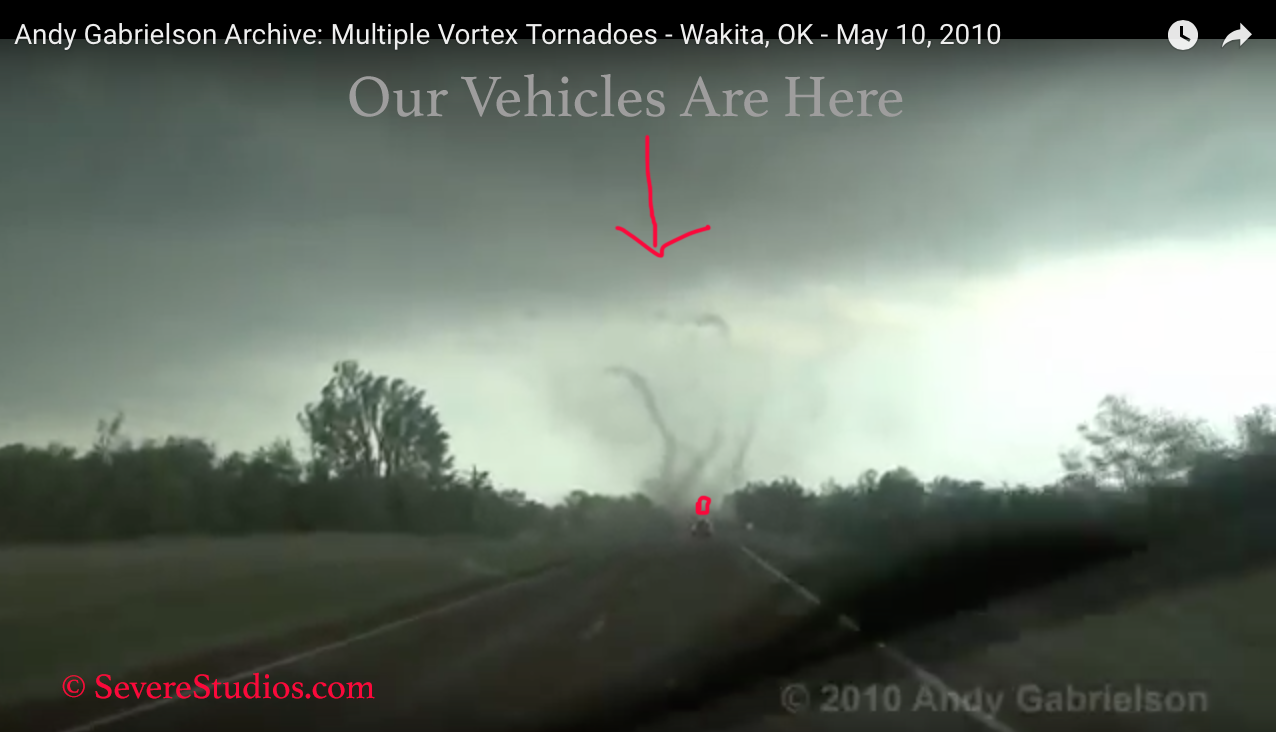 May 10, 2010 – Yet another high risk day, this time in Oklahoma, but me driving the vehicle directly behind the Dominator, for the filming of “Storm Chasers” on the Discovery Channel. My job, was to 1. Keep myself, my cameraman, my producers and the medic vehicle (and sometimes the behind-the-scenes suburban) safe. 2. Get the shots of the Dominator driving into the tornado. Well, I severely screwed up this day, panicking, instead of letting it pass.
May 10, 2010 – Yet another high risk day, this time in Oklahoma, but me driving the vehicle directly behind the Dominator, for the filming of “Storm Chasers” on the Discovery Channel. My job, was to 1. Keep myself, my cameraman, my producers and the medic vehicle (and sometimes the behind-the-scenes suburban) safe. 2. Get the shots of the Dominator driving into the tornado. Well, I severely screwed up this day, panicking, instead of letting it pass.
We were on a tornado-warned storm near Wakita, OK and it is immediately, producing quick, spin-ups, beneath an expanding base…Oh, and it’s moving northeast at 65 mph. Storm motions on this day were extremely fast, which is fairly rare for May, so you can imagine how dynamic this system was. We all pull off on this dirt road and wait for it. Reed likes to get outside when it’s close and Joel rarely gave me any indication on whether they were leaving or not. So, they finally jump back in, but the problem on this day was, it was the dominator, followed by me, then the medic vehicle, then Joel’s dad in his truck (Joel’s dad is an old rancher out in Western Oklahoma, just a great guy who loves chasing).
The rotation is nearly on top of us, and we are on an E/W highway…the Dominator parks. So, I park with them. I see a vortex spin up in the field JUST to our south and west. The Dominator, is at least armed, all we have are rented suburbans, with these metal hail guards over the top. I panic, thinking the tornado is about to develop on top of us, and a wedge is certainly going to become the outcome, really fast. So, I floor it and tell Medic to follow. Big, big, mistake. The storm is moving east/northeast (more east at this time) at 65 mph.
I get behind a caravan of chasers, going under the speed limit, and look in my rearview mirror, and see complete trees getting pulled out of the ground DIRECTLY behind the medic vehicle. My producer, Scotty K, is panicking on the radio and I try to remain calm and say, “Just floor it.” So, these vehicles, I don’t know if they were oblivious to what was going on or what, but it is every man for himself, and I’ll be damned if I am the one who gets flipped, or worse, is responsible for any injuries in our MEDIC vehicle.
We pass around 3 cars, and can feel the inflow pulling us back. I look to 10 O’clock…vortex spinning, coming our way, I look at 2 O’clock, another long, ropy vortex, spinning, coming our way. I look in the rearview and see 2 other, much larger vortices almost crisscrossing each other, on the road, directly behind the medic vehicle. I have a decision to make here—which vortex do I drive into? Which one is the weakest? Because, there is no escaping the inevitable here, if I slow down, I’m hit by, what I believe are stronger vortices, if I maintain speed, the vortex at 10 O’clock, hits us. I choose the one at 2 O’clock, as it looks smaller, and less damaging. I tell everyone to buckle up and prepare for impact, on the radio, and in the car.
Storm chasing shirts: At least $6 from each item goes to Andy Gabrielson’s family
My cameraman, Robert Seaman, the best cameraman on the planet, leaves his window down and continues to film, what could be our fate…as I floor it as hard as I can (and still could only manage about 80 mph). At the last second, Robert rolls up his window, braces against the vehicle, and keeps filming. It hits us. All I remember is watching this 2 foot wide vortex spin across our windshield, and I hear some rattling metal sound…and what seemed like an eternity, was over quickly. It had taken our metal hail guard and thrown it in the air (according to our medic vehicle) 100 feet! Their metal hail guard was thrown down, to where they couldn’t see. After it was over, there was still a developing wedge tornado RIGHT behind us, so, as the tornado seemed to have crossed the highway in my rearview, I wasn’t taking any chances, and turned south to avoid disaster.
This big wall of rain/dust and what looks like an intense downdraft was coming right at us! Frank, our medic, gets on the radio and asks me what that is…I assure him, it’s only the rear-inflow jet of the tornado, developing, as it hits us at around 80-90 mph. It was over. But, the day was just beginning and I had done something, I wasn’t supposed to, unless safety was an issue..I lost the Dominator. We would rendezvous later, in Osage county and witness more tornadoes, before calling it a day, near Henryietta, where a wedge had just dissipated before we got there. That, was a close call. And those are just 2, which I’ve shared. You guys don’t have enough space on your website for the rest!
Q: So, while you’ve been close to many tornadoes, it seems you wouldn’t necessarily suggest it for most people?
DM: I would highly advise newer chasers not getting close to tornadoes–at least until one learns storm mechanics, and has been around enough tornadoes, of all different strengths.
And even then, it’s a decision they get to make, not me. As glorious as it sounds, and as some have made it a competition to be, including myself (jokingly, usually), getting close to strong-violent tornadoes is a calculated risk and one, small, mistake could cost one their life.
TWISTEX is a perfect example, those guys were the best and had been getting close to tornadoes before I ever started chasing, and I know they didn’t anticipate a quick, 150 mph northward punch, on a southeast moving storm (although, tornadoes, when the RFD wraps almost completely around, especially strong-violent ones, will start to switch direction, in a counter-clock wise direction, usually. They honestly can move whichever way they please…and can even move backwards, in rope-out stage.)
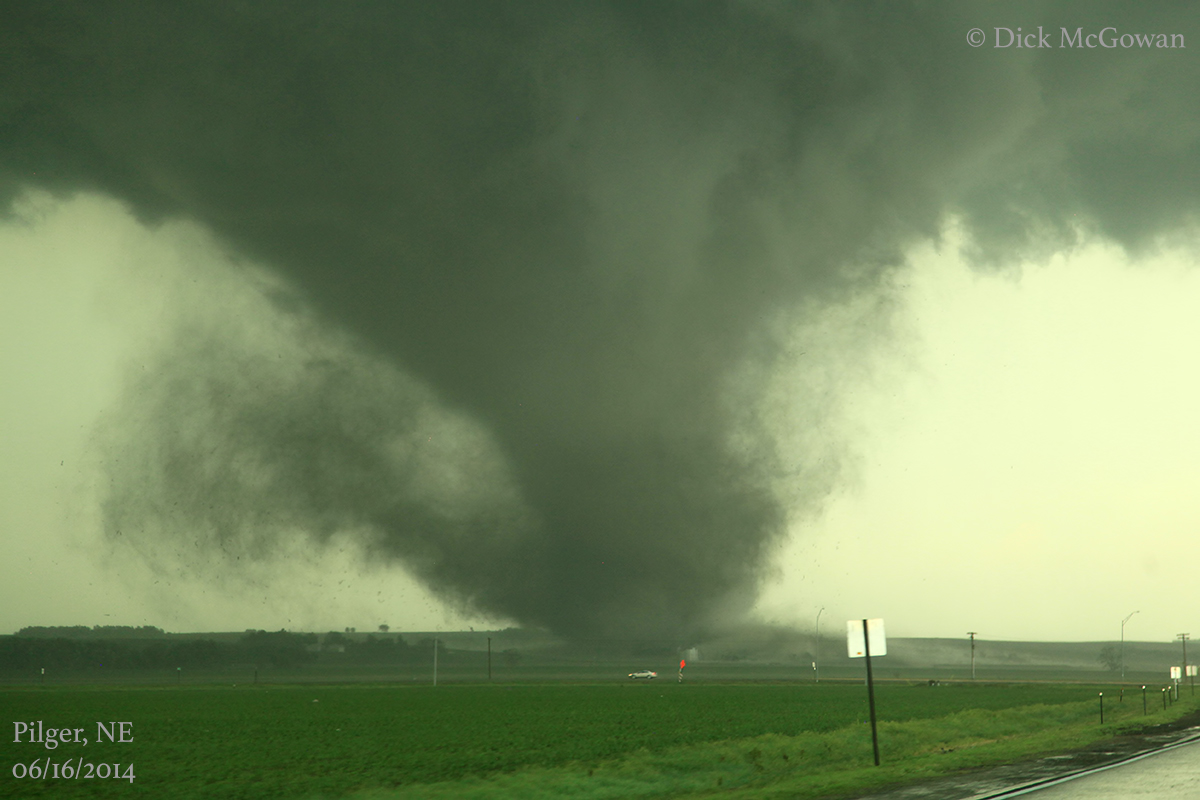 Q: What’s your all-time favorite chase or what is an ideal chase if you could design one?
Q: What’s your all-time favorite chase or what is an ideal chase if you could design one?
DM: It’s really hard to measure chases. For certain things, I can have an argument on which day was better, and still be unsure of what was the best day. In 2010 it would have been Bowdle, undeniably, up until that point.
Then I thought Rumford, SD in 2012 would be tough to beat.
Then came along Rozel, KS in 2013.
And after I thought, “How can I top Rozel?” (well, besides my filming mistakes, sigh) along came 3 days in a row in 2014! How about my all-time 3 favorite chases? June 16, 17, 18 of 2014?
June 16, 2014 – Stanton/Pilger/Wisner Nebraska. I saw 4 EF4 tornadoes, one, which, unfortunately hit the town of Pilger, NE and killed two people. I captured some of the greatest footage I ever have, and my only mistake of the day was taking a wrong road after two large tornadoes appeared to merge as one (it was an illusion)
June 17, 2014 – This was a surprising low risk day, 5 percent from the Storm Prediction Center for extreme northeast Nebraska, and much of northern Iowa. Not caring much if I busted or not, because of the day before, I woke up late in Yankton, SD and headed to Sioux City, IA. The cap was a big issue, and it finally gave way at about 7:15 p.m. The parameters suggested that anything that went up would have the potential to produce strong-to-violent tornadoes. One, lone supercell did.
The first tornado lasted about 15 minutes, with an incredible rope out. The next cycle was much bigger, and as it expanded and raced southeastward (and chased me at 80 mph, keeping up with me) made a complete stop ½ mile north of the town of Coleridge, NE., not more than 50 miles north of Pilger. It was, the most violent tornado I’ve ever witnessed, beating Bowdle in 2010 (only EF4 rated) and Philadelphia, MS in 2011 (EF5). We could feel the intensity from just the pressure drop, less than ¼ mile away, a tiny window in my car blew out, while our ears popped numerous times.
After the tornado started to shift more southeast, we tried to reposition southeast of Coleridge, but law enforcement forced me to stay back and I obliged. After that 1.3 mile wide tornado (only rated an EF-3, with the “core” of the tornado missing every farmstead, thankfully) we witnessed another 3-4 tornadoes just east of there, well into the night, almost until midnight.
June 18, 2014 – As if I cared if I saw anything this day either, and completely exhausted, both mentally and physically, I nearly screwed this day up. I couldn’t decide if a storm that formed early up north of I-80 was going to be “the storm of the day” or one that fired south of the boundary near O’Neill, NE and would move northeast towards it.
After racing to I-80, hesitating, then racing back, it was clear the ongoing storm would be the only play. With a little luck and a heavy foot, I intercepted the newest cycle of the tornado family that was south of Lane, SD. The supercell was producing quick spinups, beneath a high-based, yet strongly rotating wall cloud, so my plan was to get north to Lane, then intercept it on a road, by it, since storm motion was almost due north. I lucked out again.
When the tornado finally planted, it was just 100 yards of a perfect, north/south road exactly 1 mile east of Lane, SD and I just followed it north, from close-range. It produced ghostly-white vortices, easily the best I’ve ever seen, just to my northeast, and even rising from a nearby pond. At one point, there were 6 or 7 below the, now obvious, funnel aloft, and one literally pulled a beautiful red barn from the earth. Luckily, it missed their actual house, so we continued on. Our luck came to an end, in a close range way, when the road we were on, had a tree overlaid on a “Farmer Bob” road, that our road turned into. So, we were forced to go east 1 mile, and then north. This whole time, and for the last 2 days, I had seen maybe 2 other chasers at this point.
This tornado, unfortunately, hit a house, and I could see it doing so, during the rope-out stage, and leveled a home and killed a family dog. It was given an EF4 rating. The tornado was on the ground almost an hour and capped off the best 3 days I will probably ever have in a row. I just hope for one of these types of days, a year, and was blessed, and lucky enough to have been in the perfect places at the perfect times.
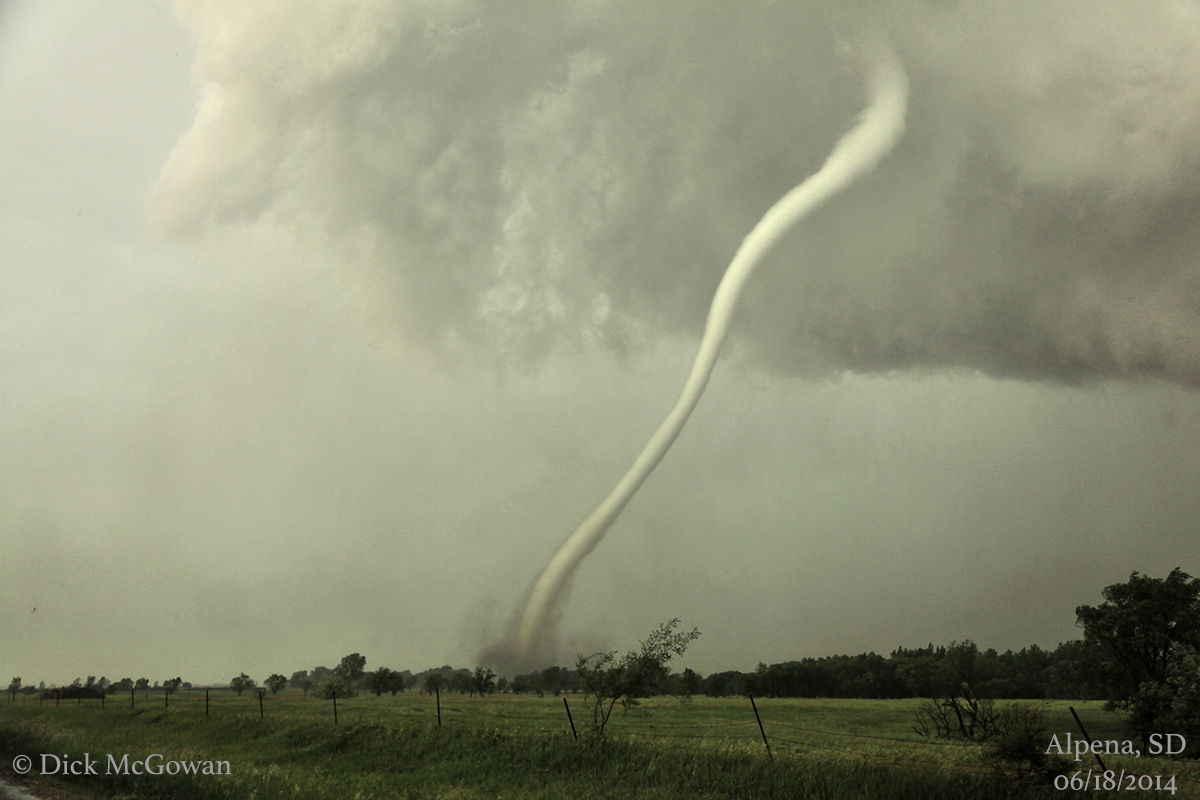 Q: Finally, since you’ve already seen it all, what are your goals for this year? And, finally finally, hope to see you out there!
Q: Finally, since you’ve already seen it all, what are your goals for this year? And, finally finally, hope to see you out there!
DM: Our goals this year are to just have a great time.
I’m rejoining my old chase partner, Darin Brunin and other chase partner, Sean Schofer, with his D3 tornado tank. A little luck, some solid forecasting, and the perfect road is a situation I’m hoping for each time we go out there, and most of all—just having fun with friends, for a passion we all share.
I’m getting too old for too many more close calls, but think I have a year or two left to give it everything I’ve got. Thanks again, for asking me to be a part of this!
Latest posts by Ian Livingston (see all)
- Top tornado videos of 2023 - January 1, 2024
- March 31, 2023 tornado outbreak videos - March 31, 2023
- Top tornado videos of 2022 - December 31, 2022
